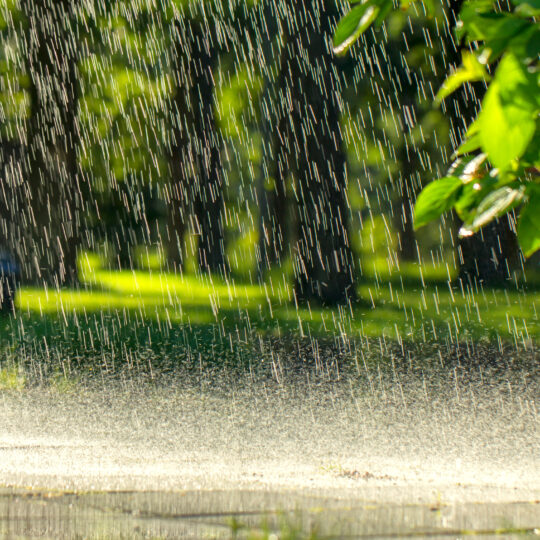Negative Effects of Natural Overwatering
How Too Much Rain Impacts Trees
Posted
June 5, 2025

Spring showers can bring more than flowers. It can also bring tree stress. Learn how natural overwatering impacts your plants and what you can do to help protect your lawn and garden.
What’s Natural Overwatering
Extended periods of rain may seem like a good idea for your plants. Hey, you don’t have to water! However, too much rain can lead to the following issues:
- Erosion. Heavy downpours can wash away mulch and topsoil, exposing roots.
- Nutrient leaching. Rain can also wash away essential minerals and nutrients.
- Oversaturated soil. Wet soil is easier to break apart, loosening the roots and increasing the chances of trees leaning or falling.
- Root rot. Without proper drainage or opportunities to dry, wet roots get dark, mushy, moldy, and decay.
- Compaction. Once saturated soil dries, it can become compacted and continue to cause drainage issues.
- Disease. Warm, damp conditions are the ideal environment for fungal growth and spreading.
- Plant stress. Too much water can drown plants and impede the proper flow of air and oxygen. Leaves may start to brown, wilt, and drop.
- Contaminated water. If you fertilize your plants, chemicals can runoff into drains and contaminate other bodies of water.
If you start to see any signs of oversaturation, such as leaf discoloration or root decay, monitor the soil moisture and take steps to help improve conditions.
Protecting Plants from Oversaturation
While you can’t control how much it rains, you can help protect your plants so the water plays a more beneficial role.
- Aerate. Ensure the soil isn’t compacted to promote better drainage.
- Mulch. Add a few inches of organic matter around the drip line of the tree. Mulch helps retain moisture and prevent erosion.
- Avoid fertilizing. Not only are chemicals more likely to wash away in the rain, plants need to focus more energy on recovering from excessive water and less on growth.
- Monitor. Check the moisture level of the soil before watering again. If it’s still moist a few inches below the surface, it doesn’t need more water.
- Support. Stake younger trees to help improve stability.
- Consult. Contact a certified arborist to assess trees that appear weak, damaged, diseased, or leaning.
While nature may give you a break from watering, there’s still work to do to ensure healthy plant growth. Take this time to set up a rain barrel to collect water for dry spells. Just give the soil a chance to dry out before giving your plants another drink.
Contact Elite Tree Care if you notice any signs of plant stress or disease. We’re here to help throughout the season—rain or shine.